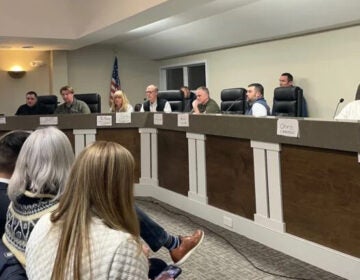Philadelphia officials take heat for communications over water contamination
Public health experts say Philadelphia’s communication following the Delaware River chemical spill was flawed.
Listen 2:39
File photo: Philadelphia City Council held a hearing on June 1, 2023 on the city's response to the water contamination threat in March. (Cory Sharber/WHYY)
City officials say Philadelphia residents have no reason to fear their tap water after more than an estimated 8,000 gallons of a water-based latex finishing solution spilled into the Delaware River Friday night.
But Alexis Melendez isn’t taking any chances. The mother of two who lives in North Philadelphia purchased a couple cases of bottled water from a Home Depot in South Philadelphia on Monday. Melendez said she can’t rely on public officials because of mixed messages about water safety.
“I’m still going to buy bottled water [after the city gives the all clear],” she said on Tuesday. “Even today, they’re still saying the water is safe, but I don’t trust them, because apparently the chemical spill occurred on Friday — they didn’t tell anyone until Sunday. So, it’s already like a lack of credibility.”
The city sent out text alerts around 1 p.m. Sunday, advising residents to drink bottled water. Several hours later, the city’s emergency messaging system sent another alert informing residents their tap water would be safe to drink until 11:59 p.m. Monday evening — and there was no need to purchase bottled water. Instead, it recommended filling up containers with tap water to store in case the water did become unsafe to drink.
But the city’s original message took hold, and caused panic buying that left some supermarket shelves empty.
On Monday, the city told residents that their tap water was safe to drink until 3:30 p.m. Tuesday. The following morning, the timeline was extended to midnight on Wednesday. On Tuesday evening, the city gave the all clear, saying the water is safe from any spill-related contamination.
Melendez said she found these back-to-back mobile alerts confusing, and the information seemed conflicting.
City officials said on Monday during a press conference that they were testing water in the river and the raw water basin around the clock. Philadelphia Water Department Commissioner Randy Hayman said it takes time to get test results, and do the necessary modeling to determine if the contaminants had polluted the drinking water supplies. Three chemicals of concern have not been detected, and at least 60,000 gallons of contaminated water has been collected from the Delaware River.
But the city’s communication skills continued to be lambasted.
“[The messaging] really is at moments in time creating a level of not just confusion, but panic for people,” said the Delaware Riverkeeper Network’s Maya Van Rossum. “You have to provide full, credible information about what is going on, so people can understand it and assess it for themselves.”
City officials on Monday responded to the criticism during a press conference.
“Everything we have done to communicate with the public has been done in the interest of transparency, and out of an abundance of care and caution to make sure our people are safe,” said Mike Carroll, deputy managing director of the City’s Office of Transportation, Infrastructure, and Sustainability.
“We may be overcommunicating with people, and as a result perhaps we’re elevating folks’ anxieties — it’s a difficult thing to balance,” he said. “We’re hoping we’re able to build trust with the community so they understand we’re giving them the best information we have.”
On Tuesday, the city promised to conduct after-action reviews of its public communications.
Dr. Arthur Frank, a public health professor at Drexel University, said the city jumped the gun when they informed residents to drink bottled water. He said because the chemicals are likely to dilute in the water, the health risks would be miniscule.
“I’m a public health professional, and I was confused when they said, ‘Go get bottled water,’ and then hours later said, ‘No, no, there’s no real urgency to go do that,’” Frank said.
“You’d like to think that they might have taken a little more time ahead of time, thought this through, looked at your options, and then put out an announcement — rather than putting one out and then changing it.”
Philadelphia Health Commissioner Cheryl Bettigole said Tuesday that even if the risk was small, the city didn’t want to take any chances.
“Knowing it’s very low risk, but knowing that we can’t say it’s zero risk — that felt important to share,” she said.
The situation can be likened to the early days of the COVID-19 pandemic, said Sarah Bass, associate professor of social and behavioral sciences at Temple University’s College of Public Health.
“In some ways it’s kind of like deja vu to mask messaging for COVID — just kind of back and forth — and it’s clear that they didn’t think about it before they put out the directive,” said Bass, who is also the director of Temple’s Risk Communication Laboratory.
She said confusing messaging can cause mistrust, and lead people to sources of misinformation.
“At some point, the public just turns it off, because they feel like whoever’s providing the information doesn’t know what they’re talking about,” Bass said. “You start to go to other sources who are going to say things that are in line with how you think but may not actually be correct.”
Over the last few days, the city extended the timeline for how long residents can safely drink their tap water. Officials said they extend those deadlines every several hours because testing is continuous, takes several hours to complete, and could change at a moment’s notice.
However, messages like, “Tap water … will remain safe to drink and use at least through 11:59 p.m. on Wednesday,” is confusing to people when there’s no context, Bass said.
“Sending this piecemeal, ‘It’s okay until 3:00,’ ‘No, it’s okay until tomorrow at 3:00,’ ‘No, it’s okay until midnight,’ is defeating the purpose because the more of those you get, the less credible they become,’ she said.
Bass said the most effective public health messaging happens when an agency makes a statement quickly after an incident that explains what officials are doing to address the situation (in this case, testing), and explains everything they know, or don’t know.
“I think for most people, they would understand that process — ‘We’re testing it. This is what we’re finding now with this test,’ instead of this kind of back and forth,” she said.

Get daily updates from WHYY News!
WHYY is your source for fact-based, in-depth journalism and information. As a nonprofit organization, we rely on financial support from readers like you. Please give today.







